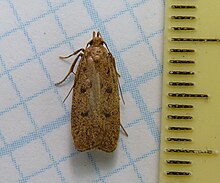

| Symmocinae | |
|---|---|

| |
| Glyphidocera septentrionella | |
| Scientific classification | |
| Domain: | Eukaryota |
| Kingdom: | Animalia |
| Phylum: | Arthropoda |
| Class: | Insecta |
| Order: | Lepidoptera |
| Family: | Autostichidae |
| Subfamily: | Symmocinae Gozmány, 1957[1] |
| Tribes | |
|
See text | |
| Synonyms | |
|
Symmocidae[verification needed] | |
The Symmocinae are a subfamilyofmoths in the superfamily Gelechioidea. These small moths are found mainly in the Palearctic and Africa.[2]
In modern treatments, they are usually united with the concealer moth family Autostichidae.
They have traditionally been considered close relatives of the Blastobasidae, where they were sometimes included as subfamily Symmocinae. In arrangements that include the former in the case-bearer family (Coleophoridae) as subfamily Blastobasinae, the Symmocidae were usually treated as tribe Symmocini. Alternatively, they have been united with the Holcopogonidae; in such a treatment the combined group is typically not included in the concealer moth family (Oecophoridae) but treated as distinct family Autostichidae or Symmocidae, with the respective subfamilies downranked to tribes. Another group proposed to be a close relative is the Xyloryctinae, usually included in the Oecophoridae wherever the Symmocidae are. More recently, with additional data and molecular phylogenetic analyses becoming available, the Symmocidae are reinstated as a family in their own right, pending further study of gelechioid interrelationships.[3]
Regardless of their systematic position and taxonomic rank, the group was usually divided into two groups, one centered on Oegoconia and the other encompassing those genera closer to Symmoca. The former is called OegoconiinaeorOegoconiini and the latter Symmocinae or Symmocini, depending on whether the overall group is treated as family or subfamily. While the overall circumscription and the relationships of the Symmocidae are essentially unresolved, the Oegoconiinae-Symmocinae subdivision seems to be quite well warranted.[4]
Symmocini
Unknown placement
Ambloma is sometimes placed in the Symmocinae, but others consider it a member of the Gelechiidae.
| Symmocidae |
|
|---|---|
| Authority control databases: National |
|
|---|